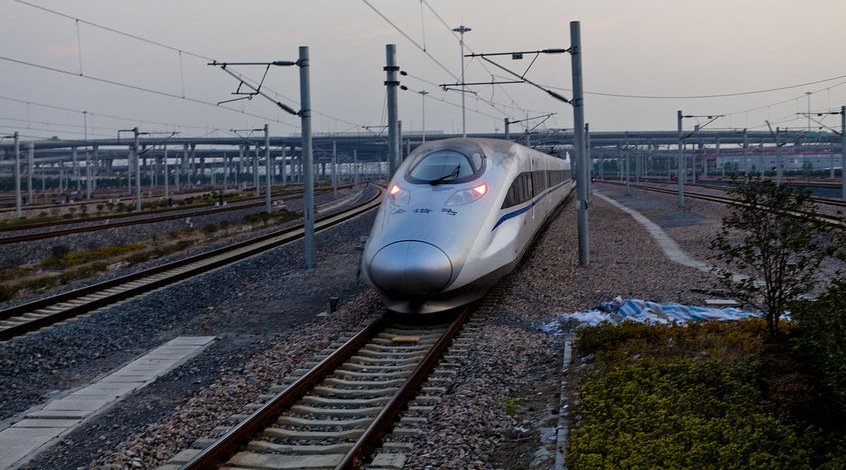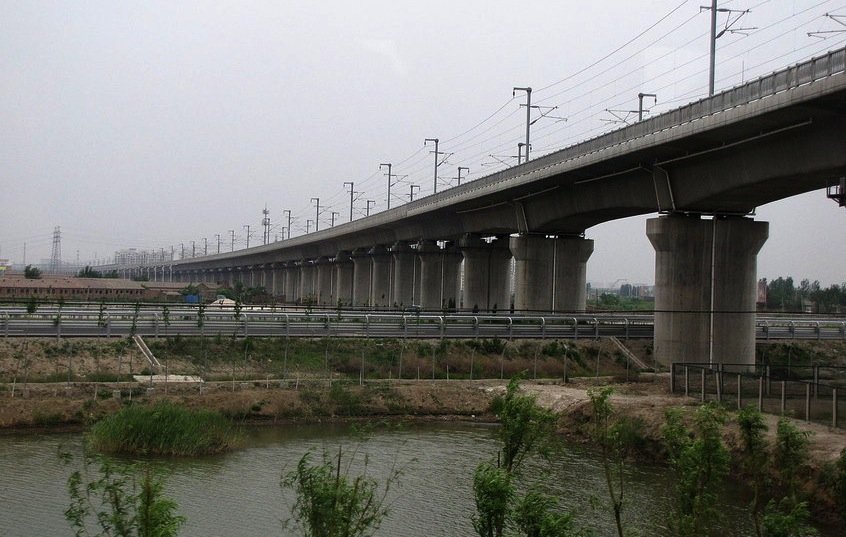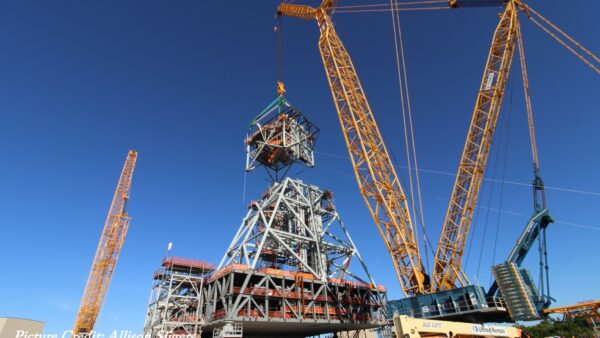In under a decade, China has built a high-speed rail network totalling more than 10,000km. It eclipses every other country’s high-speed network and even that of the entire European Union. Not only that, to build it China spent two-thirds or less what other countries have spent.
According to a World Bank paper published last week, China’s high-speed rail so far has cost between $17m and $21m per kilometre, even though it has a high ratio of big-ticket viaducts and tunnels. In Europe that figure is $25m-$39m per kilometre, while in California, the only US state currently planning a high-speed line, it’s more like $56m/km.
Some of the reasons are not surprising. For instance, in a country where according to the World Bank 978 million people lived on less than $5 a day in 2008, labour has been cheap.Â
And in an authoritarian state like China, the cost of moving people out of the way is low. The paper’s authors note that site work and right-of-way costs in litigious California are around $10m/km, or 17.6% of the total cost, while in China land acquisition and resettlement costs are below 8% of project cost.
But other reasons may be more interesting both to the developed world and to regions like Africa that are sorely in need of transformative infrastructure.

The high-speed CRH380A train leaving Shanghai Hongqiao Station (Jucember/Wikimedia Commons)
For one thing, the sheer scale of China’s rail programme and the state’s firm commitment to it unleashed the country’s technical and manufacturing capabilities. The declaration of a credible plan to build 10,000 km of high-speed rail over six to seven years energised the construction and equipment supply community, the paper says. Assured of very high volumes, companies and state institutions ramped up capacity quickly and invested in innovative techniques.
“This,” writes Gerald Ollivier, a World Bank senior transport specialist and paper co-author, “has led to lower unit costs as a result of the development of competitive multiple local sources for construction (earthworks, bridges, tunnels, EMU trains etc.) that adopted mechanization in construction and manufacturing.
“Further, large volumes and the ability to amortize capital investment in high-cost construction equipment over a number of projects contributed to the lowering of unit costs.”
The Chinese government also has the clout to standardise designs – for embankments, track, viaducts, electrification, signalling and communication systems – which cuts cost and duplication of effort.
It also standardised construction techniques. Here, the paper’s authors admired the Chinese approach to viaducts. China built a lot of these to save scarce farmland or to leap over rivers and, even though they are expensive to build, the cost was kept down by standardising the design and manufacture of viaduct bridge beams.

Beijing-Tianjin high speed railway bridge near Tianjin (Wuyouyuan/Wikimedia Commons)
Their span is standardised at either 24m or 32m and they are cast in temporary factories set up along the railway alignment. Each beam is transported no more than 8km by a specially-designed vehicle with up to 18 axles.
It was China’s handling of tunnels, however, that most impressed Ollivier et al. They noted that the Chinese system for tunnel construction resulted in a unit cost of $10m to $15m per kilometre, a fraction of what it costs New Zealand ($43m), the US ($50m), and Australia ($60m). The system allowed China to tunnel fast, as well, at a rate of five to 10 metres per day.Â
It’s little wonder, given its remarkable high-speed rail feat, that China is exporting its rail construction expertise all over the world, especially to Africa, and is even keen to help build the UK’s first significant high-speed rail network, dubbed HS2.Â
But could the benefits of the Chinese approach be realised in big, decentralised regions, like the Gulf, Africa as a whole, or the United States? It seems unlikely.
Access the World Bank report here
Comments
Comments are closed.







According to a World Bank paper published last week, China’s high-speed rail so far has cost between $17m and $21m per kilometre, even though it has a high ratio of big-ticket viaducts and tunnels. In Europe that figure is $25m-$39m per kilometre, while in California, the only US state currently planning a high-speed line, it’s more like $56m/km.
The World Bank Paper should also provide [if not provided] similar information for Malaysia where the announced cost per KM for the KL-Spore HSR Project with just 330km distance is is suspected to much higher. The information could dispel/indicate any suspicion of corruption in the award of the contract for which China is a major competitor and China has been the leading bidder for other Railway Projects in Malaysia.
Until The U.S. gets serious about transportation by developing a policy challenging the almost total reliance on the automobile and creating an infrastructure bank, we will further erode our world standing, not to mention our quality of life.
In last 15 years, rapid infrastructure development has taken place & hence there is no dearth of middle age (15 years+) Engineers possessing above experiences to be posted at project sites & having career prospects to do innovation work as well.
Retired Govt. Engineers (between 60-65 years) by and large do not posses experience, expertise, focus, passion, innovation, stamina, zeal & enthusiasms etc. which is renderings non durable & inefficient transport/ bridge infrastructures. Hence they should not be recruited / mobilized at project sites. Specialists/experts can be taken as advisors.
There is no integrity anywhere even after signing Integrity Pact by Contractor, Client & Consultant.
Ministry & Client has introduced multiple level consultants such as Design Consultant, Proof Consultant, Safely Consultant, External Auditor, and Supervision Consultant. But what is happening that all are sitting under one table & simply stamping is done.
Even highway professor/personnel are signing bridge design & drawing. Construction drawings are different from AS- Built drawing. Specifications, codes, clauses, systems, procedures are there in plenty. But it is this lack of integrity, expertise, professionalism, focus, passion, innovation, involvement, excellence, strong willed etc. which has killed everything everywhere.
This MANAGING business has killed quality, durability factors of infrastructure (specifically Transport Infrastructures) in the country.
We are only after obtaining degrees for our stomach & prestige. So who is to blame in particular & who will come forward to do the value addition?
Only turnover and number of projects running on loans have not much significance. Consultants are increasingly being appointed on the basis of lowest fees. They are treated like contractors and are required to pay earnest money. Do clients ever dare follow such an approach while selecting a lawyer, a surgeon or a chartered accountant?
Let us not lose sight of the fact that we are way behind China. Today we have the biggest mountain of debt in the history of the world and we can’t even afford to repair what we already have.
In Bihar, on river Ganges alone some 6 nos. bridges are there & dozen bridges are coming up. Almost dozen bridges are there on other rivers.
Looking into the supervision & construction standards, how much durability can be expected? Can we expect the durability of more than 150 years old Koilwar Bridge on Sone river or 117 years old Nehru Setu on Sone river in Dehri- on – Sone. Bridges built by British are still sound & under operations & bridges built by us are falling down & we are amending codes after codes.
Our roads, bridges and rail are outdated and need to be fixed. Bihar is having maximum nos. of mega bridges. Can we expect that these bridges will exist in year 2100 & afterwards?
Is India Building Bridges to Ruin?
Even highway professor/personnel are signing bridge design & drawing. Construction drawings are different from AS- Built drawing. Specifications, codes, clauses, systems, procedures are there in plenty. But it is this lack of integrity, expertise, professionalism, focus, passion, innovation, involvement, excellence, strong willed etc. which has killed everything everywhere.
This MANAGING business has killed quality, durability factors of infrastructure (specifically Transport Infrastructures) in the country. We are only after obtaining degrees for our stomach & prestige. So who is to blame in particular & who will come forward to do the value addition?
Only turnover and number of projects running on loans have not much significance. Consultants are increasingly being appointed on the basis of lowest fees. They are treated like contractors and are required to pay earnest money. Do clients ever dare follow such an approach while selecting a lawyer, a surgeon or a chartered accountant?
We have through IBMS (Indian Bridge Management System) National Bridge Inventory which gives the condition of bridges in India.
National Bridge Inspection Standards (NBIS) just in line with America which came into being on 1971 & enacted by legislation is needed in India at earliest. Its implementation must be ensured by MoRTH or NHAI.
In response to flyover collapse in Kolkatta, Varanasi & catastrophe at other places, a highway act should be added, which should prompt to develop & establish National Bridge Inspection Standards (NBIS) & National Bridge Inspector (NBI) for post construction & National Bridge/Structure supervision standards (NBSS) during construction ( for supervision consultants). There should be National Bridge Implementation Standards (for Owners/Client) which should be primarily aimed to see the speed of the work to avoid time & cost overrun & directly posed to Public & Judicial scrutiny.
As a developing nation, rapid development of transport infrastructure is happening in India like some other developing countries. The eye-popping structures have slashed travel times in some areas, made business easier and generated a sizable slice of the country’s economy, laying a foundation, in theory at least, for decades of future growth.
But as an Engineer my concern is about development/ construction of robust & durable transport infrastructures. The shortsightedness of development policies are gnawing at the foundations of bridges in the country.
Selection of construction agencies is more of the client’s requirement but where its implementation is concerned, where supervision & quality assurance is concerned, our role is important and crucial one. There are innumerable shortcomings on supervision & quality assurance’s fronts but one that relates to the selections & policy frameworks & which from my core of my heart I want that Authorities should act on it as follows:
One of the factors for poor inspection standards is the age of Supervision Engineer. Maximum age limit for supervision & quality assurance Engineer (Independent Engineer or Authority’s Engineer) is 65 years which is dangerously leading to lagging in supervision & quality assurance of the project work.
For supervision & quality assurance work, it is required to have experience, expertise, qualifications focus, passion, innovation, involvement, excellence, stamina, integrity, zeal & enthusiasms etc.The supervision & inspection Engineer shall discharge its duties in a fair, impartial and efficient manner, consistent with the highest standards of professional integrity and Good Industry Practice.
In last 15 years, rapid infrastructure development has taken place & hence there is no dearth of middle age (15 years+) Engineers possessing above experiences to be posted at project sites & having career prospects to do innovation work as well.
Retired Govt. Engineers (between 60-65 years) by and large do not posses experience, expertise, focus, passion, innovation, stamina, zeal & enthusiasms etc. which is renderings non durable & inefficient transport/ bridge infrastructures. Hence they should not be recruited / mobilized at project sites. Specialists/experts can be taken as advisors.
There is no integrity anywhere even after signing Integrity Pact by Contractor, Client & Consultant.
Ministry & Client has introduced multiple level consultants such as Design Consultant, Proof Consultant, Safely Consultant, External Auditor, and Supervision Consultant. But what is happening that all are sitting under one table & simply stamping is done. Apart from the flawed design, compromise in quality of materials and even lapses on the implementing authority’s part is a regular feature here.
Creation of National Transportation Safety Board (NTSB) & its superintendence over all reports & findings should be made. We have Commissioner of Railway Safety (CRS) in case of Railways whose sanctioning is mandatory for opening of any Railway Line or work.
NTSB should have same kind of authority.
Let us not lose sight of the fact that we are way behind China. Today we have the biggest mountain of debt in the history of the world and we can’t even afford to repair what we already have.
We are unable to build 5 Km Bridge in 15 years where as China has successfully built 55/50Km bridge in 5 years. Is there any comparison?
In Bihar, on river Ganges alone some 6 nos. bridges are there & dozen bridges are coming up. Almost dozen bridges are there on other rivers.
Looking into the supervision & construction standards, how much durability can be expected? Can we expect the durability of more than 150 years old Koilwar Bridge on Sone river or 117 years old Nehru Setu on Sone river in Dehri- on – Sone. Bridges built by British are still sound & under operations & bridges built by us are falling down & we are amending codes after codes.
Prime Minister Narendra Modi’s government has made a pledge to improve India’s decaying urban infrastructure through foreign direct investment. The construction industry is the primary beneficiary and – like in many countries – represents one of the most corrupt sectors. Calls for more transparency in campaign contributions are loud and frequent. However, a better place to start would be transparency in the bidding and contract awarding process, including publication of information about not only contractors’ qualifications but also their government connections. This practice could expose conflicts of interest and significant failures of accountability.
On toll gates, a board should be put up on every large asset, like bridges, flyovers, underpasses etc, mentioning the agency that has constructed the bridge, its age, the contractor’s name and which agency is in-charge of its maintenance. Such a board must have contact address and phone numbers of the agency concerned.
India suffers from what a government committee in 2011 called a “massive infrastructure deficit in the urban sector”. Even if overpasses stand firm, airports sparkle and metro systems hum on schedule, how long will they last? What is the life cycle of India’s new urban infrastructure, and what has been secretly compromised in construction and planning processes? Are India’s leaders and contractors “building to last”?
Our roads, bridges and rail are outdated and need to be fixed. Bihar is having maximum nos. of mega bridges. Can we expect that these bridges will exist in year 2100 & afterwards?
We must construct, develop & build the infrastructure & thus the nation with “Make In India” mantra but a robust & sustainable infrastructure.
Is India Building Bridges to Ruin?
The main issue hindering progress of mega projects in India is the effective planning. Concept and importance of “Planning” needs to be understood by all stake holders! We shall not fail to plan, lest we may plan to fail! By planning I want to clarify it is pre-construction planning and not planning during construction with Primavera etc
The other issue is reliability and accuracy of the DPR based on which bidding and execution are taken up. DPRs are often prepared without putting in required details and without reflecting the site situation. This often leads to cost and time overuns
The decision to buy or create domestic railways is about priorities. If you need capital for an industry and railway is not critical export because you have no chance to displace the incumbent then buy the railway from someone who already has sunk capital and you can enjoy their economy of scale without any investment. And spend your precious capital on an industry where you have an advantage.
I would love China to come and build a high speed railroad in Texas starting with Austin-San Antonio. China’s high speed railway system is impressive.
World Bank costs have been disputed by Alon Levy, rail transit cost researcher. He claims France has lowest overall costs by reducing viaducts and tunnels. Viaducts are not only expensive but add to noise pollution problem. Tunnels are expensive, but why China’s might be cheaper than other places is not explained here.